Young professional photographer Kristian Lammle-Ruff has chosen his own path by using his freelance commercial shooting to finance his passion for social documentary projects. He speaks to Robert Keeley.
For such a young professional photographer, 26-year-old Kristian Laemmle-Ruff has a very focused view on where he wants to direct his photographic energies. A few years ago he quit his job in a professional studio, where amongst other things he was shooting architecture and aerial images for commercial clients, so he could spend more time on his own projects.
He favours social documentary imagery with an artistic slant, and he wanted to spend more time pursuing this work. But that field of photography is notoriously hard to earn an income from, so to finance his projects he went freelance, shooting for commercial clients he attracted largely through word-of-mouth, and using the money gained to back his own ideas. In a world where images are increasingly seen as afterthoughts to a busy lifestyle Laemmle-Ruff could arguably be considered a throwback to the so-called 'golden age' of photojournalism.
His images recall the social documentary work of photographers such as Dorothea Lange and Walker Evans, who recorded the difficult lives of the working poor in Depression-era America, or perhaps the under-recognised Australian Jeff Carter, or the more recent images of the great Brazilian shooter Sebastiao Salgado (who Laemmle-Ruff nominates as one of his influences).
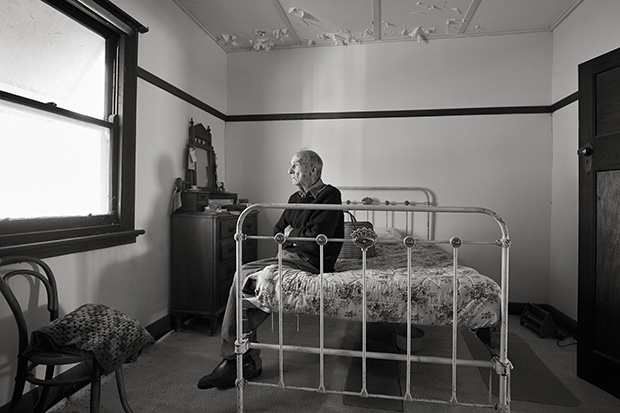
Ralph Pearce lives in the house he was born in, in Lima, Victoria. Canon 5D Mk II 16-35mm lens @19mm, 1/4s @ f/5.6, ISO 400, tripod. Capture One, curves, levels, contrast mask, high pass filter, B&W filter, Photoshop CS6.
ON-THE-JOB TRAINING
Laemmle-Ruff's interest in the craft was sparked by his father, who was a doctor as well as an enthusiastic amateur photographer. The family would take trips to various wilderness areas, like the wilds of Tasmania, or Wilson's Promontory in Victoria, and Laemmle-Ruff increasingly became interested in using his father's Nikon F3 SLR.
He'd shoot macro images of nature, like moss or stones. Then, during a 2002 trip along the isolated Franklin River, he says he "basically hijacked" his father's camera, and learned the basics of "the triangle" – shutter speed, aperture, and ISO ratings. Laemmle-Ruff studied art at VCE level, but his emphasis was always on photography. "I started to realise I could do it, and I enjoyed it. I found it rewarding. I was never a painter. I enjoy the immediacy of photography. High pace and high output suits me," he says.
When he looked up books from the famous Magnum Photo Agency, and saw a mix of social documentary images crossing over in some instances into the art world, he was impressed.
"I felt like this was the real stuff," says Laemmle-Ruff. "The older Magnum guys, they set the course."
He seriously thought about taking on photography at university, and in the meantime began shooting images for various people when opportunities cropped up, sometimes for payment. A night landscape image he took was then used for a brochure. In 2007 a contact at an ad agency saw it, and suggested Laemmle-Ruff try out for a photography and production studio which needed an assistant.
He says, "I still wanted to get into uni, but it was a job." The position dramatically changed his direction. He worked as an assistant and he says, "I had not much of an idea about that world. I'd never even used a studio flash and the pace was a million miles an hour. For the first year I came home every night exhausted. Then they started giving me more responsibility. I started shooting lifestyle, architecture and aerials. Almost every day it was something different, and I had a camera in my hand eight hours a day. When I got back from a shoot I'd learn there were always five things I could have done differently. All my potential bad habits were weeded out. It was an intense learning experience." During that period he had his first exhibition, titled "Light Unseen", featuring long-exposure night landscape images. Laemmle-Ruff says in 2010 he left the studio, partly because he found he just didn't have enough time to pursue his personal projects.
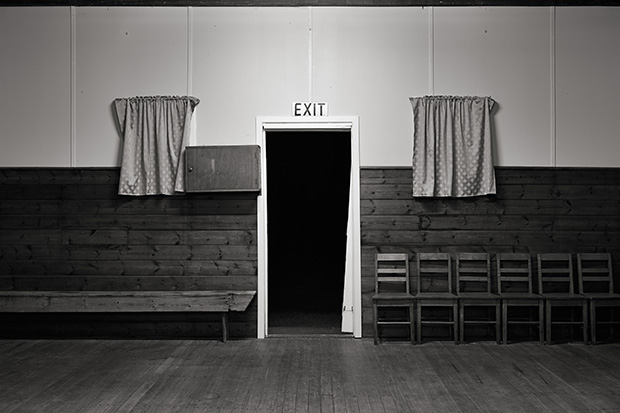
Moorngag Hall, Lima, Victoria. Canon 5D Mk II 24-70mm lens @ 48mm, 1.6s @ f/9, ISO 100, tripod. Capture One, curves, level adjustments, contrast mask, high-pass filter, B&W filter, Photoshop CS6.
OVERSEAS ADVENTURE
For a year he travelled with his girlfriend and a pared-down camera kit, which was simply a Canon EOS 5D DSLR, a 24-70mm f/2.8 zoom lens (which he used almost exclusively), a fisheye and a cheap zoom. "I wanted to be light and mobile," he says. Among other places, they visited Indonesia and Berlin, where the young photographer found plenty of inspiration. He also visited Cuba and in 2011 staged an exhibition of his images (called "Cuba") at the Carbon Black Gallery in the Melbourne suburb of Prahran. As well, he took in the sights of Mexico and Morocco. Laemmle-Ruff says his visit to Cuba had a 'sense of urgency' about it, because he felt it was a place which could change dramatically.
"The main idea of my travel was a reaction to the commercial work I'd been doing," he says. "A lot of the time you're selling products, and the purpose of the photos is to sell something, or they were part of an advertising campaign. But taking photos to tell a story, or to shock, or entertain is what excited me," he says.
As he travelled, he noted that many major cities had around their expanding outskirts what he calls "cloned houses". "So I shot them for what I thought they represented. I saw a real theme in them." He showed the images to the curator of the gallery at the Colour Factory Gallery in Melbourne and that collection became his next exhibition "Littoral" (which is a region lying along a shoreline). It explored the transition between urban and rural landscapes, or as he describes it "the littoral zone between civilisation and nature". Laemmle-Ruff says he wanted it to raise questions about our desensitisation to globalisation and over-population. It was staged in May 2012.
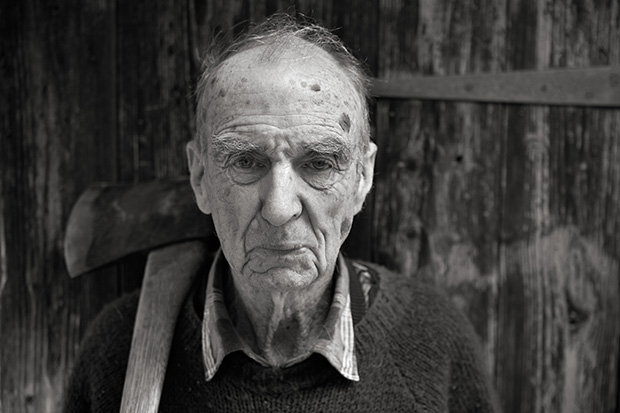
Ralph Pearce, Lima, Victoria. Canon EOS 5D Mk II, 24-70mm lens @ 55mm, 1/160s @ f/3.5, ISO 200, handheld. Capture One, curves, levels, contrast mask, high pass filter, B&W filter, Photoshop CS6.
GOING FREELANCE
In early 2011 he began freelancing. "I wanted more control over how and what I was doing," he says. He says that at first it was "kind of scary". The money which was left over from his trip, he spent on updating his equipment, then for over one year he essentially had no clients. "But I thought, 'I'll have to make it work, out of necessity.'." That first year was slow and frustrating. "It's not easy to knock on doors and get well-paid work. But there's almost a snowball effect with word-of-mouth."
His upgraded kit included (as well as his 24-70mm zoom) a Canon 16-35mm f/2.8 lens, a 70-200mm f/2.8 zoom, and a Canon EOS 5D Mk II body. But then he says he started to "become obsessed" with medium-format equipment.
So in 2013 he bought a medium-format kit. "It's lovely, but I don't use it that often," he says. That line up includes a Mamiya medium-format body with both film and digital backs, a 50mm f/4.5 lens, a 110mm f/2.8 (equivalent to 50mm in 35mm format), and a 180mm f/4.5 (or 90mm in 35mm format). Laemmle-Ruff says he has used the gear hand-held, but it's difficult. However he did use it on a recent project when he visited the Japanese nuclear zone of Fukushima.
VISITING FUKISHIMA
Laemmle-Ruff says, "I stayed near Fukushima for three or four days. I wasn't in the radiation exclusion zone, but just outside, where the refugees from the accident are located in temporary housing." Through contacts of his doctor father, he travelled to the scene along with a translator, and then worked with his medium-format kit on a tripod. He took straight portraits of the displaced and stoic survivors, but he says he wondered how he could visually convey the impact of the invisible radiation readings which had so drastically affected the lives of these people. The radiation they had absorbed was many times above the so-called 'normal' background readings, and to start with Laemmle-Ruff says it was hard to get these essentially shy people to interact. But his translator explained to them what he was doing, and once one woman came forward, keen to tell her story, others followed.
"These people were refugees and they wanted their story to be told. After we shot the first lady, everyone wanted to be part of it."
Finally he resolved the dilemma of how to convey the impact of radiation in a graphic way, by printing large translucent numbers with each individual's reading across the images in the style of a police line-up number. The impact of this technique is dramatic and disconcerting. The images from this project have been published online on a medical site under the title "Fukushima: Three Years On".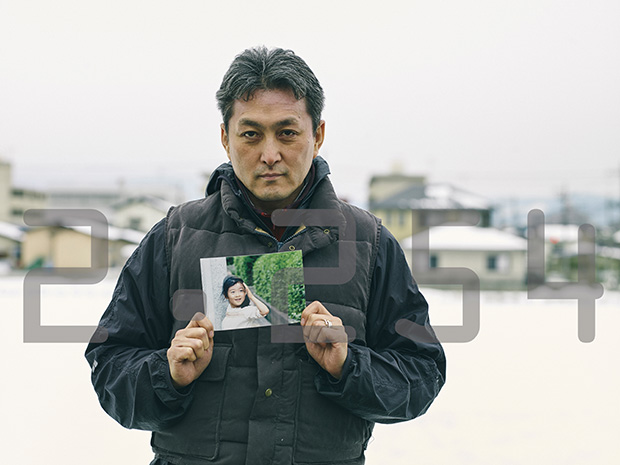
Hiroyuki Yoshino holding a photo of his daughter. The number on the image represents his radiation level. Mamiya RZ67 ProD II with Phase One P45+, 110mm f/2.8 lens, 1/90s @ f/4, ISO 100, tripod. Capture One, curves, level adjustments and sharpening in PS CS6.
IN THE FOLDS OF HILLS
Laemmle-Ruff combined the Fukushima project with a trip he made to Hong Kong while finalising another long-term project he's been working on. CIn the Folds of the Hills, an exhibition and book project, has been a much more long-term and ambitious exercise than anything he's done before. Back in 2009, Laemmle-Ruff and his mother decided to record the lifestyles, homes and working environments of a small country dairy community called Lima in northeast Victoria, where they were involved in a co-op farm. Laemmle-Ruff says he took the images, while his mother recorded the stories of the Lima families and put them into a publishable form. Laemmle-Ruff says that, having grown up on a farm, his mother had "a soft spot for farmers".
Unlike his short and confronting series on Fukushima, the 'Hills' project was long and meandering, with a sense of melancholy infusing it (though Laemmle-Ruff is at pains to point out that most of the older people he photographed also had many light-hearted memories to impart, as well as sad ones). Though the project began in 2009, and many of the images were taken in that year, it eventually ran through until last year. Laemmle-Ruff says, "Every few weeks or months we'd go up and spend a few days there. Mum interviewed the locals, and we found out a lot of interesting stuff. She pretty much just wrote everything down, though sometimes she taped it.
I took the photos, and I just wanted to disappear. The interviews focused the people somewhere else, and I didn't have to talk to them. That freed me up to just photograph them." The project ultimately extended to around 15 visits, and included straight portraits, environmental portraits, details of farming life, interiors of their Spartan homes, and even landscape images from the surrounding countryside. Laemmle-Ruff says, "I shot a lot of images – literally thousands of shots – and only 110 finally appeared in the book. It was only after I took them that I could see particular themes".
Laemmle-Ruff says he would lay 6x4in prints out on his floor and table and search for those themes, then discuss with his mother how they should be arranged in the book. "The specific order was important," he says. "A considerable part of the project was spent doing analysis. I didn't really know if I'd do a book when we started. At times we weren't sure what we were doing."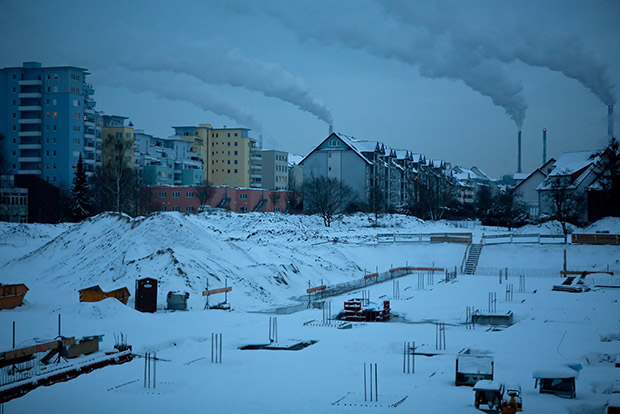
Post World War II apartments in Mannheim, Germany. Canon EOS 5D 24-70mm f2.8 @ 58mm, 1/200s @ f/2.8, ISO 400, handheld. Capture One processing with curves, level adjustments, contrast mask, sharpening in Photoshop CS6.
BOOK AND EXHIBITION
He says that in 2012 he "stated getting a bit more serious" about the whole undertaking. After some discussions with galleries failed to develop, Laemmle-Ruff decided to publish a book. He thought seriously about self-publishing, and investigated that option, but "friends talked me out of it, as it's really difficult to do everything by yourself."
He was then helped by Jason McQuoid from Melbourne's Edmund Pearce Gallery. McQuoid was developing a niche publishing arm for photography publications called Pearce Press, and he thought Laemmle-Ruff's project would be ideal for it. Design for the book started in August last year, and by December a final layout had been determined. After being shot in colour in RAW format, the final images were printed in duotone. "It was a huge learning curve," says Laemmle-Ruff, "There was a lot involved that I'd never done before." He flew to Hong Kong to check the proofs off the presses (and completed his Fukushima project at the same time).
He shot many of the images with his Canon EOS 5D Mk II and a 24-70mm lens. "I didn't want the medium-format pressure. I wanted to be in the moment. Some shots I used a tripod, but a lot were quite loose. I think they have a certain charm and authenticity. Around 60-70 percent worked in colour, but probably 30-40 percent weren't great in colour. There was fluoro light and other issues. That's when I said 'let's go black and white'. I was thinking of my favourite shooters at Magnum." He also rarely used flash. He relied on available light, did almost no cropping, and also says he did little substantial editing, though he did undertake some complex minor adjustments in Photoshop to get them ready for print. The book was launched in May 2014, along with a series of exhibitions in Melbourne and Sydney, and finally in the town Swanpool (in the old movie house there), near Lima.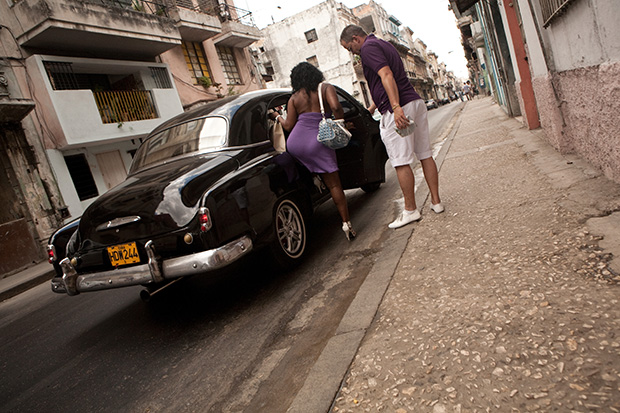
Havana, Cuba. Canon 5D, 24-70mm lens @ 24mm, 1/500s @ f/5.6, ISO 400, hand held. Curves, level adjustments and sharpening in
PS CS5.
GEAR AND POST-PRODUCTION
Laemmle-Ruff works with Capture One and Photoshop. He checks highlights, then makes other adjustments in Photoshop. On the book project veteran photographer and post-production expert Tim Handfield assisted Laemmle-Ruff with his digital workflow. At the time of writing, Laemmle-Ruff lived in an open-plan shack in the back of a rambling timber house on a steep hill outside the bushy northeast Melbourne suburb of Warrandyte. His commercial work is often done on-site. For processing he uses a Macbook Pro laptop, and he has a lighting kit with two 500 Watt Bowens flash heads, two 100 Watt units, and umbrellas and softboxes. He shot a short video on the Canon 5D Mk II to promote the "Hills" project, and says there is an increasing amount of work in this field but he's not that keen to pursue it. "You become part of a big team. What I enjoy is 'stills' work. It's really just you and the camera and that's it," he says. "I have all those years of experience. It's about the thought processes. I really believe in that philosophy; not gear for gear's sake. It's about the story, and how you feel about it."
More information: www.inthefoldsofhills.com









